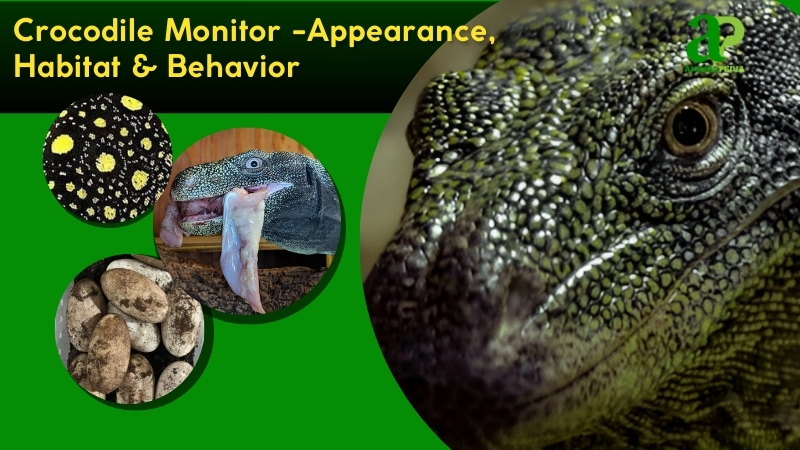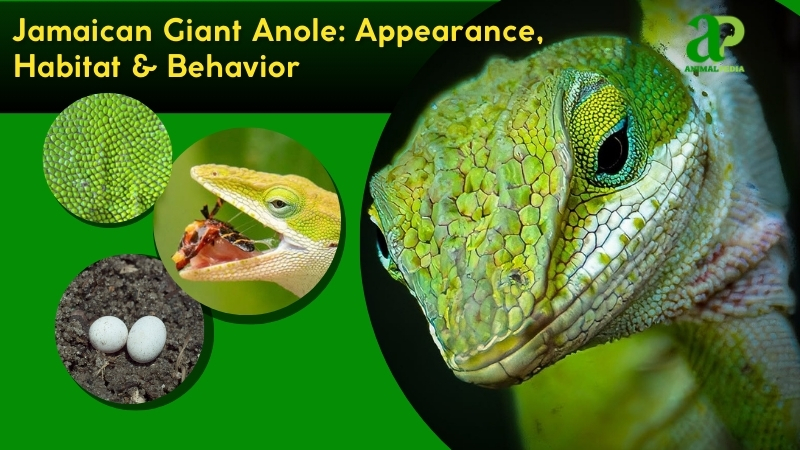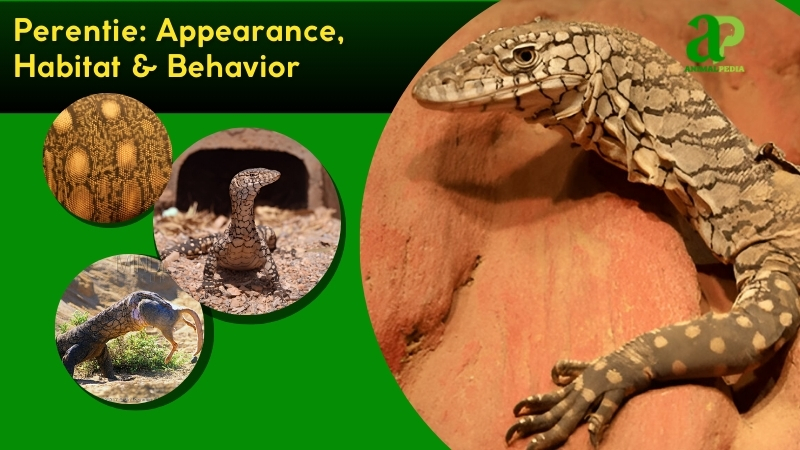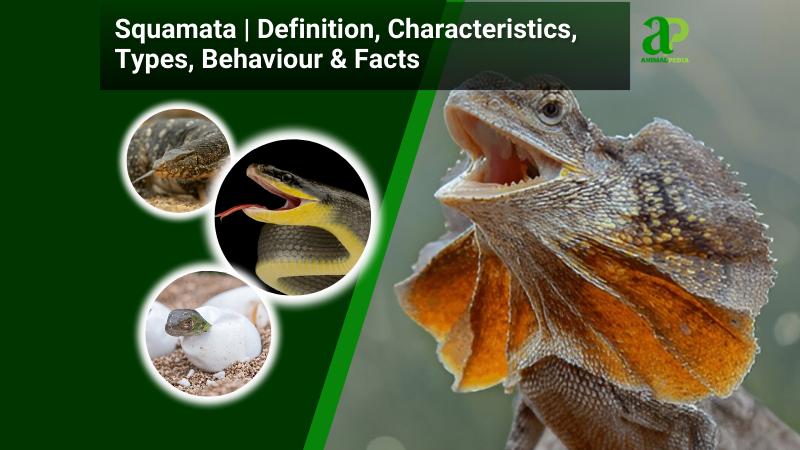Texas horned lizards command attention with their prehistoric look. Thirteen species exist in the Phrynosoma genus across North America. Their spiky armor and unusual behaviors make them unique. This piece covers their appearance, habitat, and behavior—revealing the science behind these reptiles.
The Texas horned lizard (Phrynosoma cornutum), often called the horned toad, features a flat, wide body covered with horn-like spines. They measure 3 to 5 inches long with earthy colors—browns, tans, and grays—that blend with their surroundings. Native to regions from Texas to northern Mexico, their camouflaged skin and distinctive crown separate them from other lizards.
These reptiles thrive in arid plains, grasslands, and deserts with sandy or rocky terrain. Their range covers the southwestern United States, particularly Texas, Oklahoma, and parts of Arizona, extending into northern Mexico. Harsh sunlight and minimal vegetation define their environment. They regulate body temperature by basking on rocks or burrowing underground—a testament to their evolutionary adaptations.
Though not top predators, they hunt with precision. Harvester ants form their main diet, along with beetles and spiders. They hunt by waiting motionless, then capturing prey with their sticky tongues. Their most unusual defense? Squirting blood from eye capillaries to repel predators like coyotes. Around humans, they are docile unless threatened.
Mating occurs in spring, April through June. Females deposit 13-45 eggs in sandy burrows by July. After 40-50 days of incubation, hatchlings emerge measuring just over an inch. Independent from birth, they grow quickly and reach maturity within two years. Their lifespan averages 5-8 years, influenced by predation and habitat quality.
This examination of Phrynosoma cornutum—from its distinctive appearance to its desert habitat and survival behaviors—shows nature’s ingenuity in harsh environments.
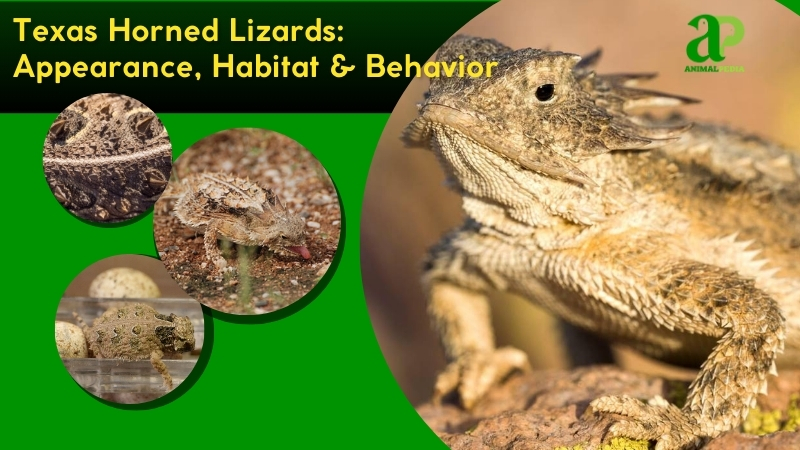
What do the Texas Horned Lizards look like?
The Texas horned lizard has a flat, broad oval body measuring 3-5 inches long. Its mottled coloration of browns, tans, and grays provides perfect camouflage in its native habitat. Keratinized scales cover its rough skin, with distinctive horns projecting from its head—the lizard’s most recognizable feature.
The lizard displays several key physical traits: a blunt snout, small bead-like eyes, and a sticky tongue that extends from a wide mouth. Its pancake-like torso connects to a short neck, while short, sturdy legs with sharp claws support its low profile. A short tapering tail completes its compact form.
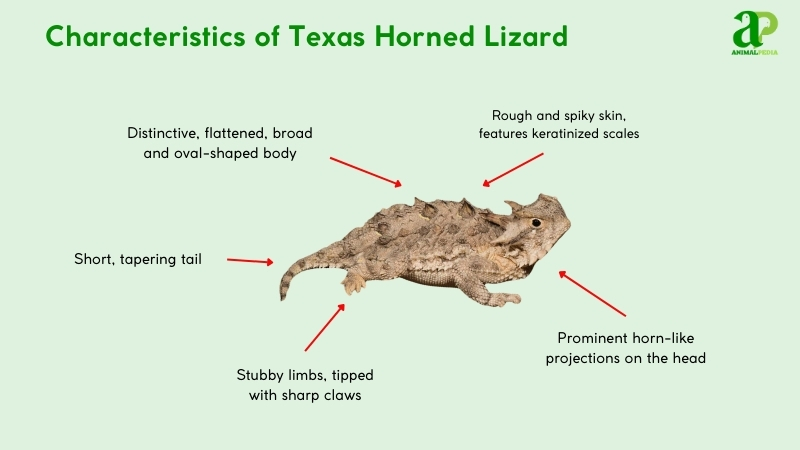
Unlike the short-horned lizard (Phrynosoma hernandesi), the Texas species has longer cranial horns and a wider body. Its head spines are more pronounced than the subtle bumps found on the desert spiny lizard (Sceloporus magister). The Texas horned lizard’s dense dermal spines provide superior defense compared to its smoother-scaled relatives. These physical adaptations make it a master of desert survival, uniquely equipped for both concealment and protection.
Learn more about the Sungazer species, a fascinating spiny lizard known for its defensive posture and armored scales adapted to the grasslands of southern Africa.
How big do Texas Horned Lizards get?
Texas Horned Lizards average 3.5 to 5 inches (9 to 13 centimeters) in length and 1 to 3 ounces (28 to 85 grams). Females typically grow larger than males.
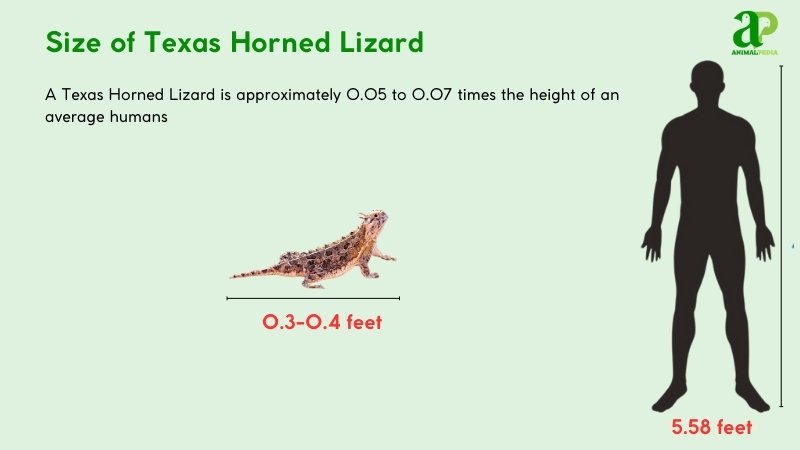
The longest recorded specimen, found in Texas, reached 7.1 inches (18 centimeters), according to a 2019 study by Texas Christian University (Heuring et al., 2019). The heaviest, at 4.2 ounces (119 grams), emerged from the same research, highlighting rare extremes.
Adult lizards typically reach 4 to 5 inches (10 to 13 centimeters) snout-to-tail. Males average 3.7 inches (9.4 centimeters) and 1.5 ounces (43 grams), while females hit 4.5 inches (11.4 centimeters) and 2.5 ounces (71 grams). This sexual dimorphism reflects reproductive demands. See the table below for key differences.
| Trait | Male | Female |
| Length | 3.5–4 in (9–10 cm) | 4–5 in (10–13 cm) |
| Weight | 1–2 oz (28–57 g) | 2–3 oz (57–85 g) |
What are the unique physical characteristics of the Texas Horned Lizards?
The Texas Horned Lizard has distinctive physical traits unlike any other reptile species. Its body is flat and covered with spiny protrusions, most notably the crown of cranial horns on its head. These horns serve as effective deterrents against predators. When threatened, this lizard employs autohemorrhaging—shooting blood from its eyes up to 5 feet. Its camouflage coloration blends perfectly with the rocky, arid Texas terrain.
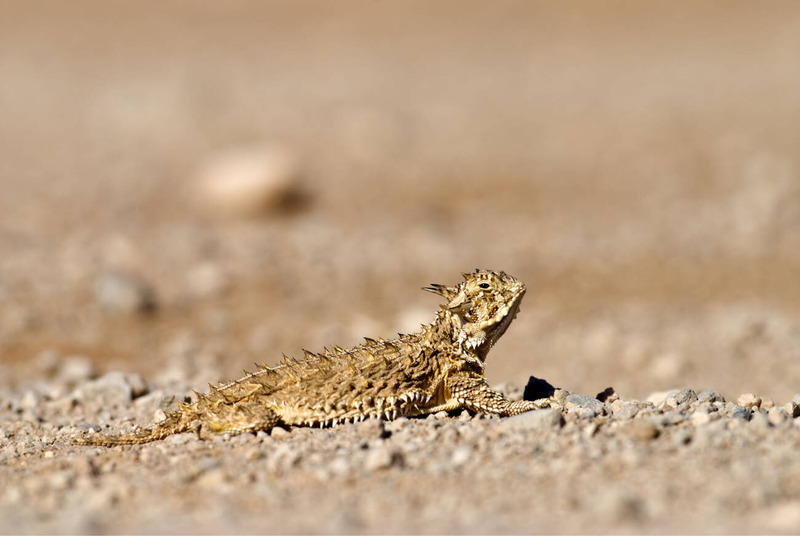
The horn structures develop from ossified scales, a unique morphological adaptation within the Phrynosoma genus (Sherbrooke & Middendorf, 2016). The blood-squirting defense mechanism operates through specialized ocular sinuses that build pressure. Research by Heuring et al. (2019) identified specialized muscles that control this response, which don’t exist in other reptiles. The lizard’s wide torso—up to 2 inches (5 centimeters) across—helps with both thermoregulation and concealment in its desert habitat.
These evolutionary adaptations represent a masterful design against predation. The combination of defensive armament, mimicry, and active deterrence makes the Texas Horned Lizard an example of specialized physical characteristics shaped by its environment.
How do Texas Horned Lizards adapt with their unique features?
Texas Horned Lizards (Phrynosoma cornutum) survive harsh desert environments through adaptations. Their most dramatic defense is blood-squirting from eye capillaries—a process called autohemorrhaging that deters predators like coyotes and raptors. Their flattened bodies and crown-like horns provide dual benefits: camouflage among rocks and protection from attacks.
These reptiles possess highly specialized sensory systems that enhance survival. Sharp vision detects movement at a distance, while acute hearing identifies approaching threats before they arrive. Their temperature-sensitive skin helps regulate body heat in extreme desert conditions, allowing precise thermoregulation through strategic basking. Specialized olfactory capabilities help them locate harvester ants, their primary food source in the Southwestern ecosystems they inhabit.
The morphological adaptations work seamlessly with behavioral strategies to create an integrated survival system. Their cryptic coloration matches regional soil types, providing effective concealment from both aerial and ground predators. Research by Sherbrooke and Middendorf (2016) demonstrates how these combined adaptations have allowed Texas Horned Lizards to persist in predator-rich environments where resources are scarce and conditions are extreme.
Anatomy
Texas Horned Lizard has evolved a suite of specialized systems that allow it to thrive in harsh, arid environments. These adaptations are key to its survival in the dry, hot landscapes of the southwestern United States.
- Respiratory System: Lungs with a high surface area handle arid conditions. Efficient oxygen uptake supports energy needs in low-moisture habitats (Sherbrooke, 2016).
- Circulatory System: The Compact heart pumps blood fast. Sinus pressure enables autohemorrhage—blood squirting from the eyes as a defense (Heuring et al., 2019).
- Digestive System: Short gut digests ants swiftly. Specialized enzymes break down chitin, optimizing nutrient absorption from its primary prey (Heuring et al., 2019).
- Excretory System: Kidneys conserve water tightly. Uric acid excretion minimizes hydration loss, a key factor in desert life (Sherbrooke, 2016).
- Nervous System: Acute brain processes threats rapidly. Sharp sensory nerves enhance predator detection and prey tracking in harsh terrains (Sherbrooke, 2016).
This structure helps to set up the context at the beginning and wraps it up with a conclusion that ties everything together.
Where do Texas Horned Lizards live?
Texas Horned Lizards inhabit the southwestern United States and northern Mexico. They thrive mainly in Texas—particularly the Panhandle and Edwards Plateau regions—as well as Oklahoma, New Mexico, and Arizona. In Mexico, these reptiles populate Chihuahua and Sonora. Their range consists primarily of arid, open terrain.
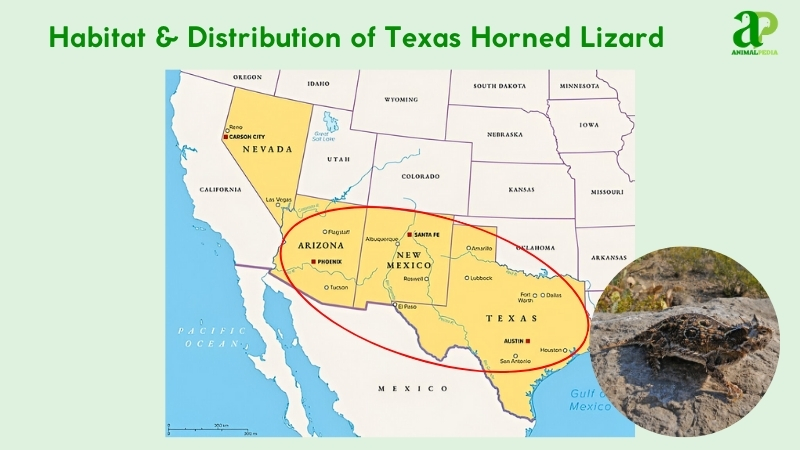
The ideal habitat for these horned reptiles features sandy soils, sparse vegetation, and rocky outcrops. These elements provide perfect camouflage opportunities and basking sites. Hot, dry climates support their thermoregulation needs and sustain harvester ant populations—their primary food source.
Research by Heuring and colleagues (2019) confirms these environmental conditions align with their physiological requirements. Fossil evidence indicates these lizards have occupied these regions for millennia without significant range shifts. Scientific studies correlate their distribution with prey availability and predator-avoidance strategies rather than with seasonal migration patterns.
How do seasonal changes affect their behavior?
The Texas Horned Lizard exhibits seasonal behavioral patterns finely tuned to the extreme conditions of its desert habitat. These changes allow it to maximize survival and resource efficiency across varying climates.
- Spring: They emerge from hibernation, basking to warm up and foraging actively.
- Summer: Peak activity hits. They hunt ants voraciously and mate, fueled by heat (Sherbrooke, 2016).
- Fall: Foraging slows. They fatten up, preparing for hibernation as temperatures drop.
- Winter: They hibernate underground, metabolism crashing to conserve energy in the cold.
These shifts, driven by seasonal climate changes, are essential for the lizard’s survival in arid zones. By adjusting its behavior in response to available resources and temperature fluctuations, the Texas Horned Lizard optimizes energy use and adapts to the harsh desert environment.
What is the behavior of Texas Horned Lizards?
Texas Horned Lizards are reptiles adapted to life in arid environments. Their behaviors, finely tuned to survive in harsh conditions, reflect a solitary existence focused on efficient foraging and defense.
- Feeding Habits: They devour ants, especially harvester species, using quick tongue flicks. Studies show the Texas Horned Lizard’s diet drives their ecology (Heuring et al., 2019).
- Bite & Venomous: They don’t bite or produce venom. Blood-squirting eyes deter threats instead.
- Daily Routines: Active by day, they bask mornings, hunt midday. Nights mean burrowing or stillness.
- Locomotion: Slow, deliberate walks match their camouflage. Short bursts evade predators.
- Social Structures: Loners, they shun groups. Mating season sparks brief encounters.
- Communication: Silent, they rely on body signals. Horn displays ward off rivals.
These adaptive behaviors allow the Texas Horned Lizard to thrive in its challenging, dry habitat. Their unique survival strategies make them fascinating creatures within the arid ecosystems they inhabit.
What do Texas Horned Lizards eat?
Texas Horned Lizards are strict carnivores, favoring harvester ants above all. These ants dominate the Texas Horned Lizard diet, per Heuring et al. (2019). They don’t attack humans—too small, too focused on insects. They snatch ants whole, swallowing fast. Bigger prey, rare for them, risks choking—their jaws can’t handle it.
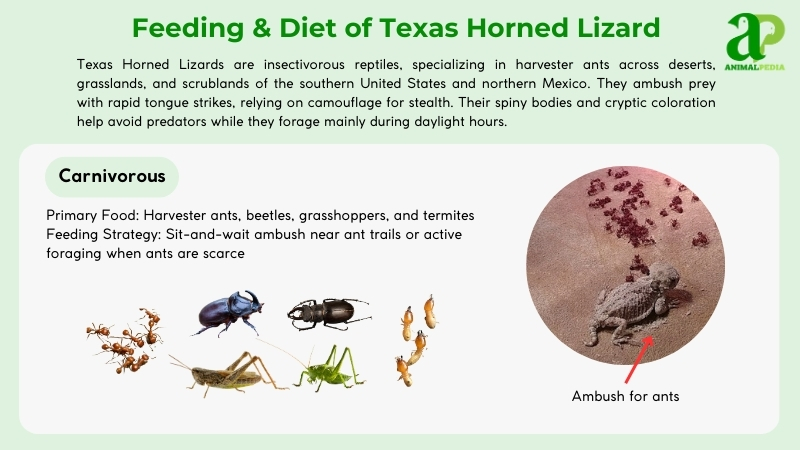
- Diet by Age
Texas horned lizard diets change as they mature. Hatchlings primarily consume small ants and insects. As they grow, they target larger ant species, particularly harvester ants. Adults continue to rely on ants, especially during active foraging periods.
- Diet by Gender
Both male and female Texas horned lizards feed on ants, with no significant differences between the sexes. However, larger males may cover more ground in search of food, given their larger size and larger territories.
- Diet by Seasons
In spring and summer, lizards forage intensively, relying on abundant ants. As temperatures drop in fall and winter, they slow their foraging and enter a period of hibernation, surviving off stored energy.
How do Texas Horned Lizards hunt their prey?
Texas Horned Lizards have a clever hunting strategy that combines stealth and precision. These reptiles use their excellent camouflage to blend into their surroundings and patiently wait for unsuspecting insects to come close. When the moment is right, they swiftly dart out their tongues to capture prey with accuracy.
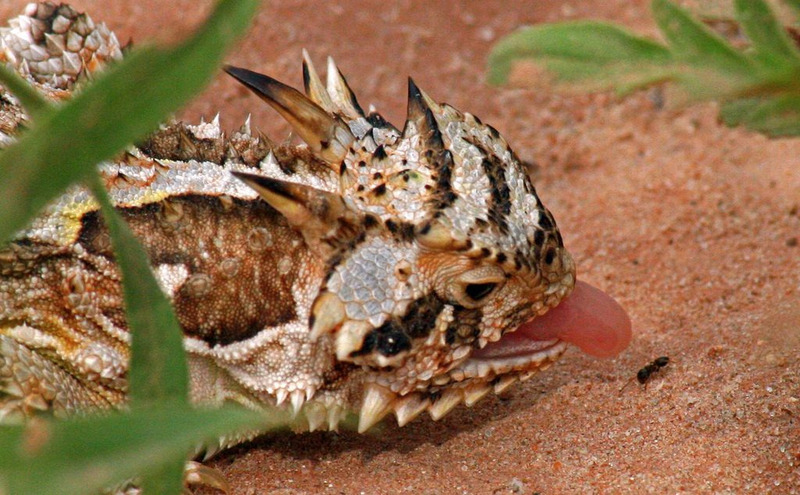
These lizards in Texas have a unique hunting strategy, relying on keen eyesight and quick reflexes to catch ants, beetles, and other small insects. Their diet mainly consists of these tiny creatures, which they catch with impressive skill.
With their sharp horns and protective scales, Texas Horned Lizards excel at surviving in the wild. They’re skilled hunters, using a mix of patience and agility to secure their next meal.
Observing these fascinating creatures hunting in their natural habitat is truly captivating, showcasing their hunting abilities.
Are Texas Horned Lizards venomous?
Unlike some lizards, they don’t have venom glands. Instead, they’ve developed intriguing ways to protect themselves from predators.
One of their most defensive tactics is the ability to shoot blood from their eyes when threatened. The blood contains chemicals that taste bad to predators, deterring them from attacking. This unusual behavior has evolved as a survival strategy, helping the lizards escape danger.
In addition to blood-squirting, Texas Horned Lizards can puff themselves up to appear larger and more intimidating to potential threats. These behaviors showcase their resourcefulness in defending themselves without resorting to venom. Observing Texas Horned Lizard adaptations in the wild, which is unique, makes them a truly captivating species to study.
When are Texas Horned Lizards most active during the day?
Texas Horned Lizards are most active during the early morning and late afternoon hours, making these times ideal for spotting them in action. They emerge to bask in the sun’s warmth, hunt primarily for harvester ants and small insects, and perform their essential thermoregulation behaviors.
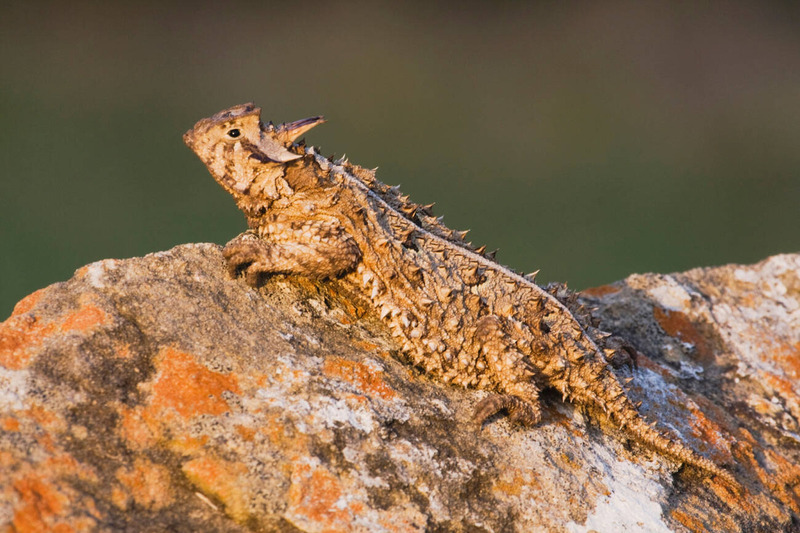
These crepuscular activity periods are vital for Phrynosoma cornutum’s survival, as they use solar radiation to maintain optimal body temperature, which facilitates digestion and metabolic processes. The bimodal activity pattern helps these reptiles avoid the extreme midday desert heat while still acquiring sufficient energy for their daily biological functions.
How do Texas Horned Lizards move on land and water?
Texas Horned Lizards move with efficiency on land. They use their powerful hind legs to sprint across desert terrain, reaching speeds that help them escape predators. Their low-profile bodies and sharp claws provide excellent traction on a variety of surfaces, including sand, rocks, and prairie soil. These desert dwellers demonstrate exceptional terrestrial mobility when hunting their preferred prey—harvester ants.
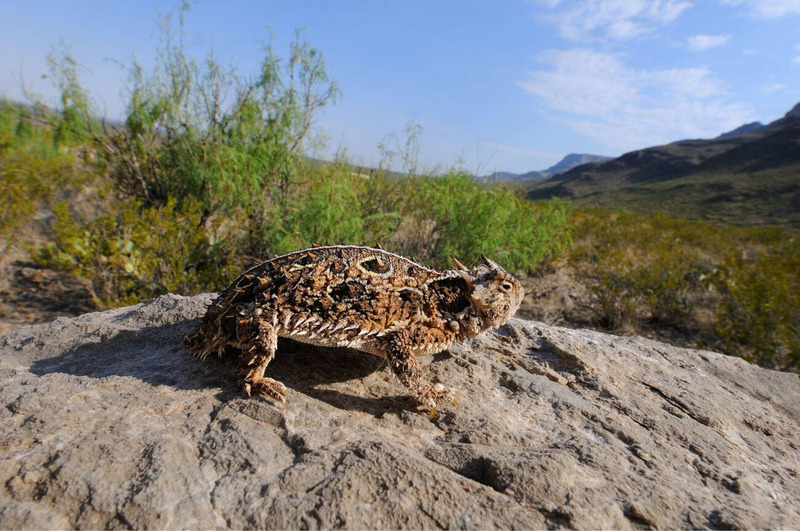
On land, these reptiles exhibit a distinctive stop-and-go motion, pausing to scan for threats before making quick dashes to new locations. Their locomotion pattern includes both quadrupedal running and short bursts of bipedal movement when maximum speed is needed. The Phrynosoma cornutum relies on this agility to thermoregulate, moving between sun and shade throughout the day.
Water navigation presents challenges for Texas Horned Lizards. Unlike their desert adaptations, they show poor swimming ability and actively avoid aquatic environments. When confronted with water, they may attempt a doggy-paddle motion but cannot sustain effective swimming. These lizards have evolved for xeric conditions, not aquatic habitats, and their body structure lacks the hydrodynamic qualities needed for efficient water movement.
Do Texas Horned Lizards live alone or in groups?
Texas Horned Lizards (Phrynosoma cornutum) live solitary lives. These iconic reptiles hunt and travel alone across their arid habitats in the southwestern United States. Their independent lifestyle reflects their specialized ecological niche as ant specialists, primarily feeding on harvester ants.
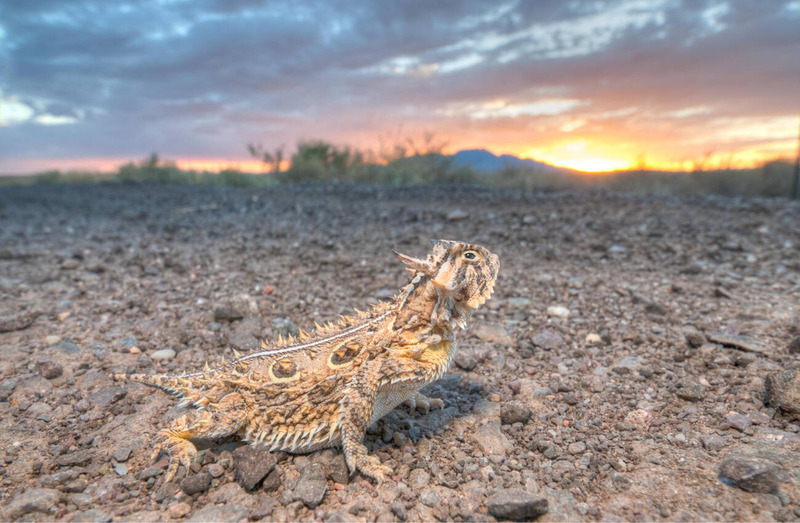
While occasionally found near other horned lizards during breeding season or in prime basking areas, they don’t form social groups or cooperative units. This solitary behavior supports their survival strategy, allowing each lizard to maintain its own hunting territory without competition from conspecifics.
The territorial nature of these lizards contributes to their distribution across the landscape. Adult Texas Horned Lizards typically maintain personal space of several hundred square meters, with minimal overlap except during mating periods. Their solitary existence is an evolutionary adaptation that helps these desert-dwelling reptiles thrive in resource-limited environments.
How do Texas Horned Lizards communicate with each other?
In their dry habitats, Texas Horned Lizards communicate through a variety of non-vocal behaviors. They use body postures and movements to convey messages. For defense, they puff up to seem larger and wave their tails to distract predators.
Socially, they head-bob during territorial disputes and courtship rituals. Through these gestures, Texas Horned Lizards establish boundaries, attract mates, and show dominance in their environment. Overall, their communication tactics play a crucial role in their survival and interactions within their arid landscapes.
How do Texas Horned Lizards reproduce?
Texas Horned Lizards reproduce through oviparity, laying eggs rather than giving birth to live young. The breeding season begins in late spring, typically May to June. Male lizards initiate courtship by inflating their bodies, bobbing their heads, and pursuing females. Females signal reproductive receptivity by tilting their tails. Copulation is brief and straightforward, lasting only minutes.
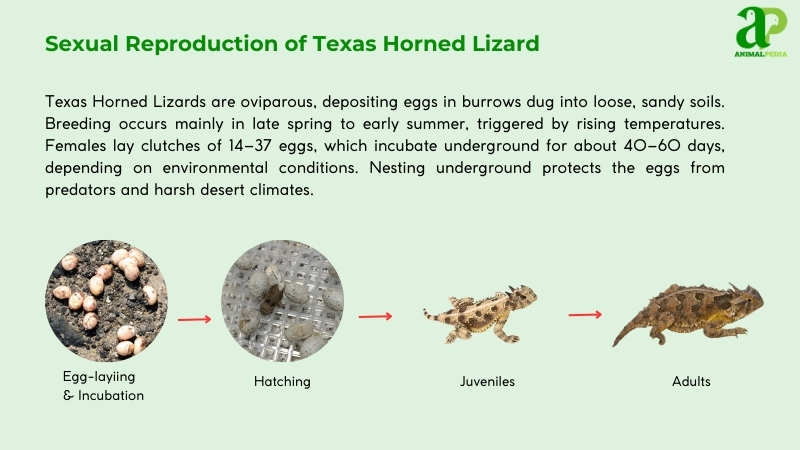
After successful mating, female horned lizards deposit 13-37 eggs in June or July. Each egg weighs approximately 0.1 ounces (3 grams) (Sherbrooke, 2016). Females dig shallow, sandy nesting burrows for egg deposition, then abandon them without providing parental care. Males contribute nothing to offspring care and depart after mating. Environmental stressors such as drought can inhibit reproduction—research from 2018 shows that arid conditions significantly reduce clutch size (Heuring et al., 2019).
Incubation takes 40-60 days, with eggs hatching in late summer. Hatchlings emerge measuring about 1 inch (2.5 cm) in length and must immediately fend for themselves, feeding primarily on small ants. Their growth rate is rapid, with sexual maturity occurring within two years. Lifespan in these reptiles typically ranges from 5 to 8 years. Importantly, habitat degradation poses a serious threat to reproductive success rates in wild populations.
How long do Texas Horned Lizards live?
Texas Horned Lizards (Phrynosoma cornutum) typically live 5-8 years in their natural habitat. Some specimens reach longer lifespans in captivity under controlled conditions. Both males and females show similar longevity patterns.
These iconic desert reptiles face survival challenges, including predation from hawks, roadrunners, and coyotes. Habitat fragmentation and agricultural development threaten their populations across their range in the southwestern United States. Their annual cycle includes a hibernation period (brumation) during winter months and active foraging throughout spring and summer.
The lizards reach sexual maturity around age two, when they begin participating in annual breeding cycles. Their distinctive diet consists primarily of harvester ants, which affects their distribution and survival rates. Conservation efforts focus on protecting these threatened species across Texas, Oklahoma, and neighboring states.
What are the threats or predators that Texas Horned Lizards face today?
Texas Horned Lizards battle habitat loss, climate change, invasive species, and predation. These threats shrink their numbers fast.
- Habitat Loss: Urban sprawl and farming wipe out nesting sites. Populations drop 30% in altered zones (Heuring et al., 2019).
- Climate Change: Droughts cut ant prey, stressing reproduction. Clutch sizes shrink in dry years (Sherbrooke, 2016).
- Invasive Species: Fire ants outcompete native ants, reducing food availability. Lizards weaken, per studies (Heuring et al., 2019).
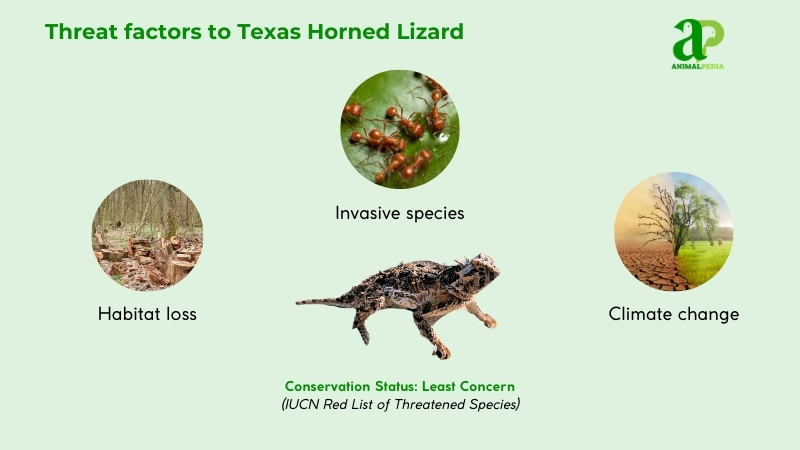
Predators include hawks, roadrunners, snakes, and coyotes. Hawks swoop on basking lizards. Roadrunners snatch them from burrows. Snakes, like rattlers, strike at night. Coyotes dig them up in open terrain.
Humans hit hardest. Pesticides kill ants, starving lizards. Roads fragment habitats, boosting roadkill—up to 15% of deaths. Research from Heuring et al. (2019) shows that introduced populations falter as urbanization spikes. Conservation lags, amplifying these blows.
Are Texas Horned Lizards endangered?
Texas Horned Lizards face endangered status in parts of their range. They’re threatened in Texas, Oklahoma, and other states despite their broader distribution.
The Texas Parks and Wildlife Department lists them as a protected species under state law. While the IUCN classifies Phrynosoma cornutum as “Least Concern” globally, regional populations have crashed by up to 90% since the 1960s. Their decline stems from habitat fragmentation, fire ant invasions, and pesticide use that affect their primary food source—harvester ants.
Population density varies dramatically by location. Healthy habitats support 2-5 lizards per hectare, but many areas show local extinction. Research by Henke and Fair (2021) documents range contraction across the Southwest. Conservation efforts include captive breeding programs at the Fort Worth Zoo and habitat restoration initiatives in the Trans-Pecos region. Without intervention, these iconic horned reptiles face an uncertain future despite their cultural significance as the Texas state reptile.
What conservation efforts are underway?
Texas Horned Lizards benefit from focused conservation efforts across the state. The Texas Horned Lizard Reintroduction Project, launched by the San Antonio Zoo’s Center for Conservation and Research in 2017, works to restore native populations throughout Texas. Key collaborators include the Texas Parks and Wildlife Department and Texan by Nature, both of which strengthen this multi-year restoration initiative.
While federal protection is absent, Texas designated the species as threatened in 1967. This status prohibits the capture, sale, or possession of these reptiles without proper permits—protecting wild populations from collection pressures. Enforcement includes financial penalties to ensure habitat preservation.
Captive breeding programs show progress. The San Antonio Zoo’s specialized “Lizard Lab” has successfully released nearly 200 hatchlings into native habitats since 2017, including 50 juveniles in 2024 alone. Fort Worth Zoo achieved a significant milestone in 2019 when their released specimens survived winter and reproduced naturally—the first documented instance of captive-bred horned lizards breeding in the wild. Oklahoma City Zoo’s head-start initiative with Tinker Air Force Base has enhanced the survival rates of young lizards, with successful releases documented in 2020.
The Horned Lizard Conservation Society provides crucial research funding supporting these conservation successes. A notable achievement occurred in 2023 when CCR-released specimens produced offspring in natural settings, validating the effectiveness of reintroduction strategies. This collaborative effort between zoological institutions and wildlife agencies demonstrates promising results for the recovery of this iconic Texas reptile.
Frequently Asked Questions
Can Texas Horned Lizards Shoot Blood From Their Eyes?
Yes, Texas horned lizards can shoot blood from their eyes as a defense mechanism. This unusual ability startles predators and gives the lizard a chance to escape. It isn’t harmful to the lizard but can deter threats effectively.
Do Texas Horned Lizards Make Good Pets?
Yes, they do! Texas Horned Lizards make great pets for reptile enthusiasts. They require specific care, including a suitable habitat, a proper diet, and regular check-ups. Remember, they are unique animals with individual needs.
How Do Texas Horned Lizards Protect Themselves From Predators?
When threatened, Texas Horned Lizards puff up to seem larger, hiss, puff blood from their eyes, and run in short bursts. This display can deter predators, giving you time to escape.
Are Texas Horned Lizards Endangered or Threatened?
You’ll be relieved to know that Texas horned lizards are currently listed as a species of least concern. Their populations appear stable, but conservation efforts are crucial to ensure their long-term health.
Can Texas Horned Lizards Change Their Color Like Chameleons?
Yes, Texas Horned Lizards can change their color. Like chameleons, they modify their hue to blend with their surroundings or to regulate body temperature. This amazing adaptation helps these creatures camouflage effectively, avoiding predators and regulating their environment.
Conclusion
Texas Horned Lizards represent evolutionary success in harsh desert ecosystems. Their distinctive defensive adaptations—from crown-like cranial spines to specialized scales—serve as critical survival mechanisms in arid environments. These herpetological marvels employ sophisticated camouflage techniques, thermoregulatory behaviors through strategic basking, and specialized dermis capable of moisture absorption through rainfall harvesting.
The Phrynosoma cornutum exemplifies biodiversity resilience in southwestern habitats. Their specialized diet of harvester ants and unique blood-squirting defense mechanism from ocular sinuses demonstrate nature’s intricate adaptational responses to predatory threats. Conservation efforts are vital as these iconic reptiles face habitat fragmentation and population decline across their native range.
When traversing the desert landscapes of the American Southwest, observe carefully—these cryptic specialists blend into their surroundings, offering glimpses into nature’s evolutionary ingenuity under extreme environmental conditions.





